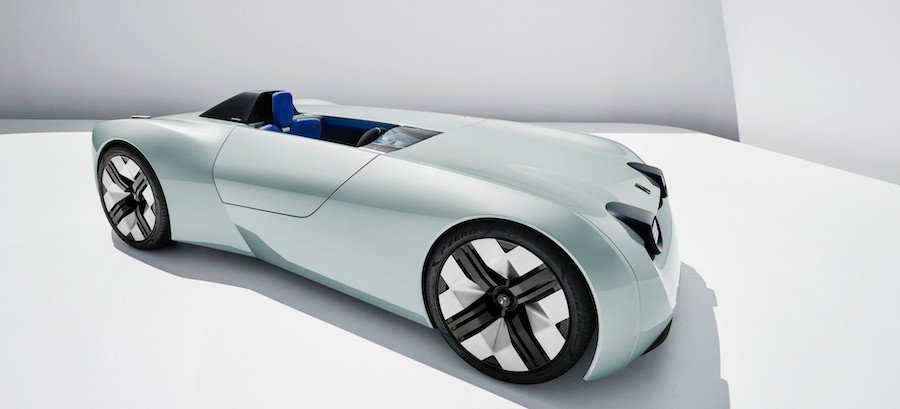Triumph TR2 returns as lightweight electric sports car

In a move certain to set the pulses of Triumph lovers racing, a London-based design house has launched an all-new electric two-seat sports concept that not only carries the famous British marque’s badge but does so with the express permission of BMW, which own the rights to the name today.
The TR25, which has an arrestingly simple and extremely modern shape, is the work of a secretive London-based automotive design house called Makkina and sets out to show that cars in the electric era can be simple fun, just as they were in Triumph’s heyday.
It uses the chassis, battery and major running gear of BMW’s all-electric, rear-drive i3 commuter car that appeared in 2013 and went out of production last year. However, the concept’s shape is intended as an homage to the most famous Triumph TR2 of all, the 1953 'Jabbeke' record-breaker that set a new speed mark for sub-2.0-litre production sports cars on the famously straight Belgian motorway 70 years ago.
The name and work of TR25’s designer and builder, Makkina, is well known to the bosses of the giant OEMs who are its clients but means little to the wider public because its work has always been behind closed doors. In fact, according to Makkina’s founder and director, Michael Ani, this project is the company’s first-ever public reveal. As well as marking Triumph’s centenary as a car maker and the 70th anniversary of the Triumph TR2, the TR25 concept’s emergence celebrates Makkina’s own quarter century.
Although the TR25 has been produced with the blessing of BMW, there is no suggestion that it will become a production car. True, Ani refers to Triumph as “an incredibly important name in the motoring industry” and dubs his project a “reawakening”. But the TR25 is also firmly referred to as an homage to the Jabbeke car and a one-of-a-kind show car.
Manchester-raised Ani, who trained in design at the Royal College of Art, says his company’s speciality is taking brands and projecting them forward. With the TR25, he says, “it was important to create a statement that suits the marque’s British identity in a context relevant to today.”
The project took about a year to complete, beginning after Ani was inspired by a single black-and-white image of car and driver. “We were hooked on the car’s record-breaking capability, and how the design helped make that possible,” he says. Concepts were first drawn on paper, then transferred to CAS (computer-sided styling). Once the design was validated, it was milled as a full-size model from high-density foam. Even in full size, it is undoubtedly smaller than most cars, being just four metres long and barely one metre tall, around 50cm lower than the BMW i3 S donor car.
The finished TR25 show car, built in Germany, is startlingly simple but plainly echoes the essential features of the Jabbeke TR2, including its short front overhang and longer, narrower tail. Like the record-breaker, it’s a single-seater (with its driver on the right) and the door swings upwards to allow access. The seat is in blue leather, like the original. The headlights – which between them spell out '25' – echo the original’s bug-eyed lighting design. There’s a buttress behind the driver’s head to provide roll-over protection and it includes a discreet rear-view camera. Even the 1950s Triumph badge has been modernised.
Inside, a modern steering wheel design recalls the spoked affairs of 1950s Triumphs and has a single, self-centring dial in its hub. A simple central binnacle carries three more dials showing speed, charge level and range.
The TR25 even comes with an impressive set of specifications: an estimated kerb weight of 1095kg (200kg less than an i3 S), plus notional 0-62mph acceleration of 5.2sec and a top speed of 115mph. The touring range, an estimated 190 miles, also benefits from the TR25’s lighter weight.
The original TR2 record-breaker, whose 124.889mph narrowly beat a 120mph mark set by its rival, the Sunbeam Alpine, resides today in the British Motor Museum at Gaydon, having been bought for the nation in 2020 using a £250,000 National Heritage Memorial Fund grant.
Based around a standard TR2 but with 'optional' aerodynamic addenda such as an undershield and wheel spats, it was actually a pre-production model, officially unveiled at the 1953 Earl’s Court show. Triumph aficionados say the record, with its attendant publicity, strengthened Triumph’s marketing after a shaky start with the poor-performing TR1, helping the company take its share of booming US post-war sales of British sports cars.
Will the TR25 spring into production and stimulate another life for Triumph cars? There’s currently no comment about that from the builders, but it’s very unlikely. It’s far more likely that the TR25 will provide a way for Ani and Makkina to progress their business into a new phase. Even so, the TR25 definitely hits its creators’ target – to make a small EV roadster as desirable as roadsters ever were.
Verwandte Nachrichten
